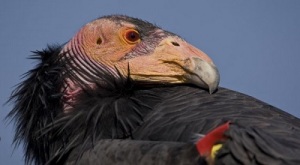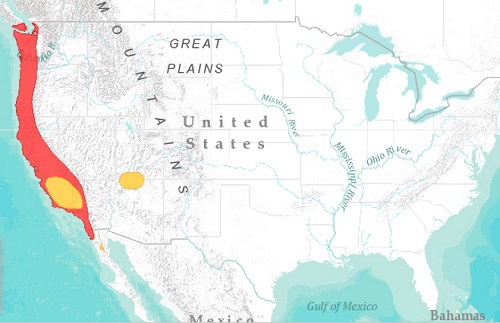Taxonomy

A California condor raised in captivity at the San Diego Zoo. This species is classified as critically endangered by the IUCN Red List of Threatened Species.
- Kingdom: Animalia
- Phylum: Chordata
- Class: Aves
- Order: Cathatiformes
- Family: Cathartidae
- Genus: Gymnopyps
- Species: Gymnogyps californianus
Name
- Scientific name: Gymnogyps californianus.
- Common name: California condor.
0
Physical Features
- The plumage of the California condor is black with white patches of white feathers on the underside of their wings. These patches are visible when flying.
- Like their relative, the Andean condor (Vultur gryphus) , they have bald head and no feathers on their neck which helps them keep clean when poking inside carcass.
- The skin of both head and neck fluctuates from yellow, white, red or orange. The color changes according to emotional state.
- Condors have sharp, hooked bill for gripping prey and ripping into the flesh.
- Males and females have the same plumage color and are similar in size.
- Younger condors have mostly black plumage with gray feathers on the underside of their wings. Their heads are dark until about 3 or 4 years old when they start changing to pink.
- They rely on their eye sight to find food, they do not have a good sense of smell.
Habitat and Distribution
- The California condor is one of the 7 species of New World vulture found in warn and temperate areas of the American continent.
- Its original distribution stretched along the western United States coast from Canada to Mexico.
- Currently they can be found in isolated areas where they have been reintroduced: southern California, Baja California and the Grand Canyon.
- They inhabit rocky forested regions and roost in cliffs and large trees.
- Between 1988 and 1991 there were no California condors in the wild. In 1987 the last 22 condors were taken into captivity to save the species.
- In 1992 they were reintroduced and efforts continue today. As of the end of 2013 there were 239 condors in the wild.

Yellow areas show resident populations. Red areas show native range where populations are possibly extinct. Source: IUCN Red List of Threatened Species
Size and length
- The California condor has the longest wingspan of any North American bird at a range of 2 to 9.8 ft or 2.49 to 3 m.
- Their length ranges from 43 to 55 in or 109 to 140 cm.
- Their weigh ranges from 15 to 31 lb or 7 to 14 kg.
Behavior
- The California condor communicates by making low hissing sounds and using body postures.
- They also communicate by changing the color of the skin in their neck and head which conveys different emotional states.
- California condors are monogamous.
- These animals spend most of their time searching for food. They travel up to 150 miles or 250 kilometers and can soar up to 15,000 feet or 4,600 meters. They reach speeds of 55mph or 90 km/h.
- Social hierarchy is seen when feeding. Dominant condors eat first.
- California condors like to roost on high cliffs where they use thermal currents to fly. Ones they reach sufficient altitude they glide without flapping their wings.
Diet
- California condors are carnivores and opportunistic scavengers. They feed mostly on carcasses of dead animals (carrion) such as deer, cattle or large rodents.
- They are not predators.
- After eating they clean their necks and heads against a rocky or grassy surface.
Reproduction
- California condors like their relatives, the Andean condor, reproduce slowly. They lay one egg every other year.
- They reach reproductive age at 6 to 8 years old and mate for life.
- Mating season is from winter to spring.
- California condors do not build a nest instead they find a suitable place on rock crevices, holes in large trees or cave openings.
- Both parents share the incubation and the care of their young.
- Incubation lasts an average of 56 days.
- If one egg is removed the female will lay a second or a third. Scientists began collecting eggs for captive incubation.
- The young leaves the nest at 5 to 6 months old.
Life Expectancy
- They can live up to 60 years.
Threats
- Adult California condors do not have predators other than humans. Eggs or young condors may be prey to eagles.
- Low reproduction rate, one egg every other year.
- They have a late reproductive maturity at 5 to 6 years of age.
- Power line collisions and lead poisoning.
Conservation Status
- The IUCN Red List of Threatened Species lists the California condor as a “Critically Endangered” species.
Did you know?
Due to efforts to reintroduce the California condor in the wild most of them wear a numbered identification tag and transmitter.
References and further research
U.S. Fish and Wildlife Service
California Department of Fish and WIldlife
